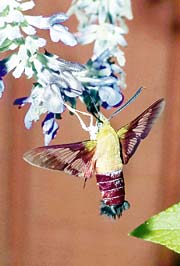
moth. At the peak of the sun's activity, the trees can defend themselves
Direct link to this page: https://www.hayadan.org.il/shemeshash.html
The population of many moth species increases or decreases in nature in a cyclical manner. These cycles last years and maybe even decades. When the number of moths suddenly increases, they can wreak havoc - for example, eating all the leaves in a grove in one afternoon.
Now a group of Norwegian scientists puts forward an interesting hypothesis, according to which it is possible that at least in some cases the cyclic outbreaks of the insects are related to the activity of the sun and the amount of ultraviolet radiation coming from the sun to the earth. The researchers reviewed data taken from the forests of theresa trees in southern and central Norway, where the size of two moth populations was measured over a 30-year period. The researchers compared this data with data about sunspots at the same time and found a negative correlation - in years when there were few sunspots, the amount of moths was large, and vice versa. The research findings were published in the journal "Biology Letters".
Sunspots are an indication of solar activity, which increases in 11-year cycles. At the peak of the activity, called the "period of peak solar activity", there is more ultraviolet radiation of type C. This radiation does not reach the surface of the earth, but it causes the amount of ozone in the atmosphere to increase. The ozone prevents some of the harmful ultraviolet B radiation from reaching the earth.
According to the explanation offered by the researchers, during the "period of low solar activity", when there are fewer sunspots and the levels of type B ultraviolet radiation are higher, the Teresa trees are required to produce more protective pigments that act as natural sunscreens. However, this activity speeds up the metabolism of the trees and as a result they produce smaller amounts of other compounds that protect them from leaf-gnawing pests. According to the researchers, additional studies, which will be conducted under controlled laboratory conditions, are needed to test their hypothesis.
New York Times
They know evolution in action
https://www.hayadan.org.il/BuildaGate4/general2/data_card.php?Cat=~~~948325720~~~12&SiteName=hayadan
